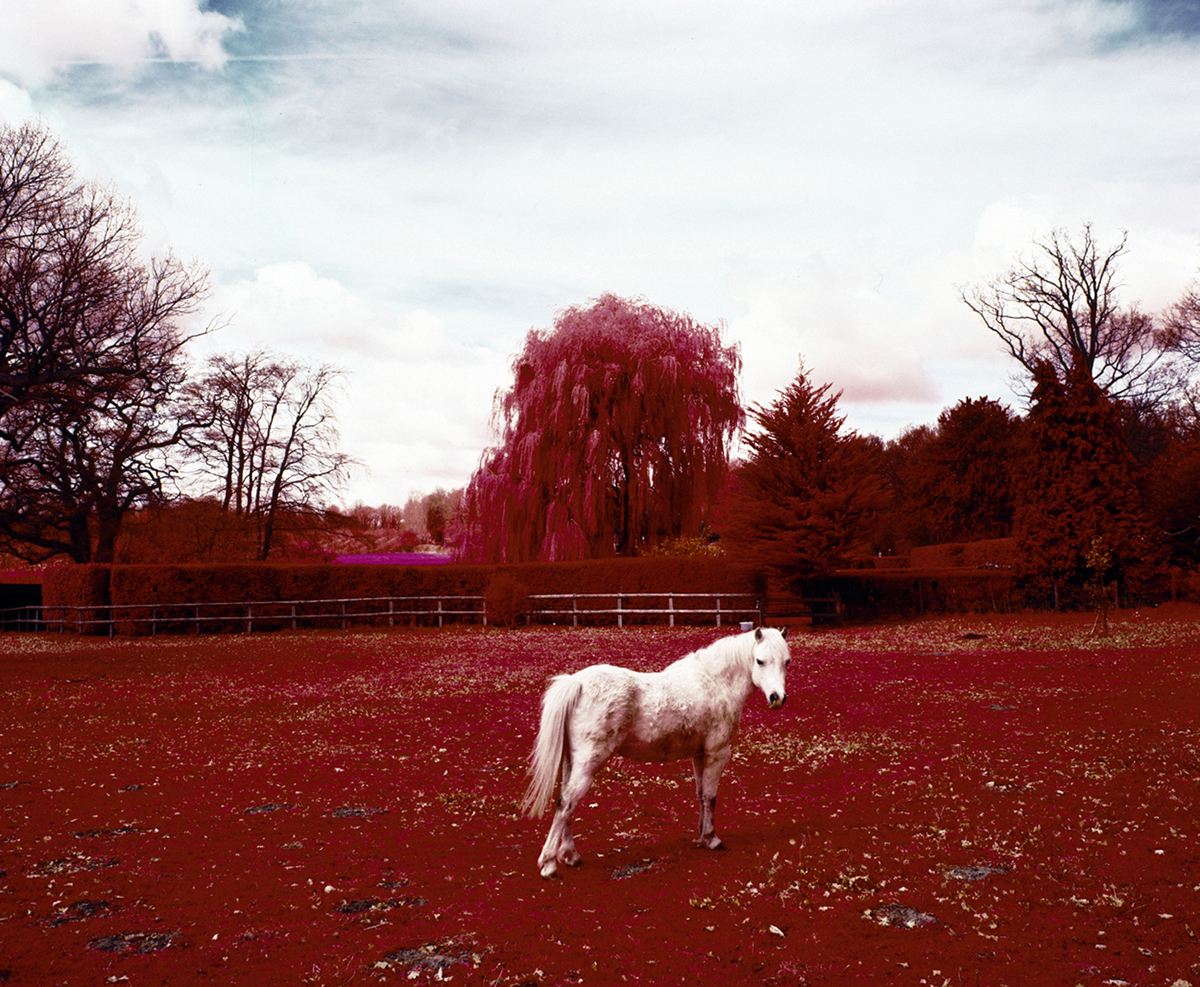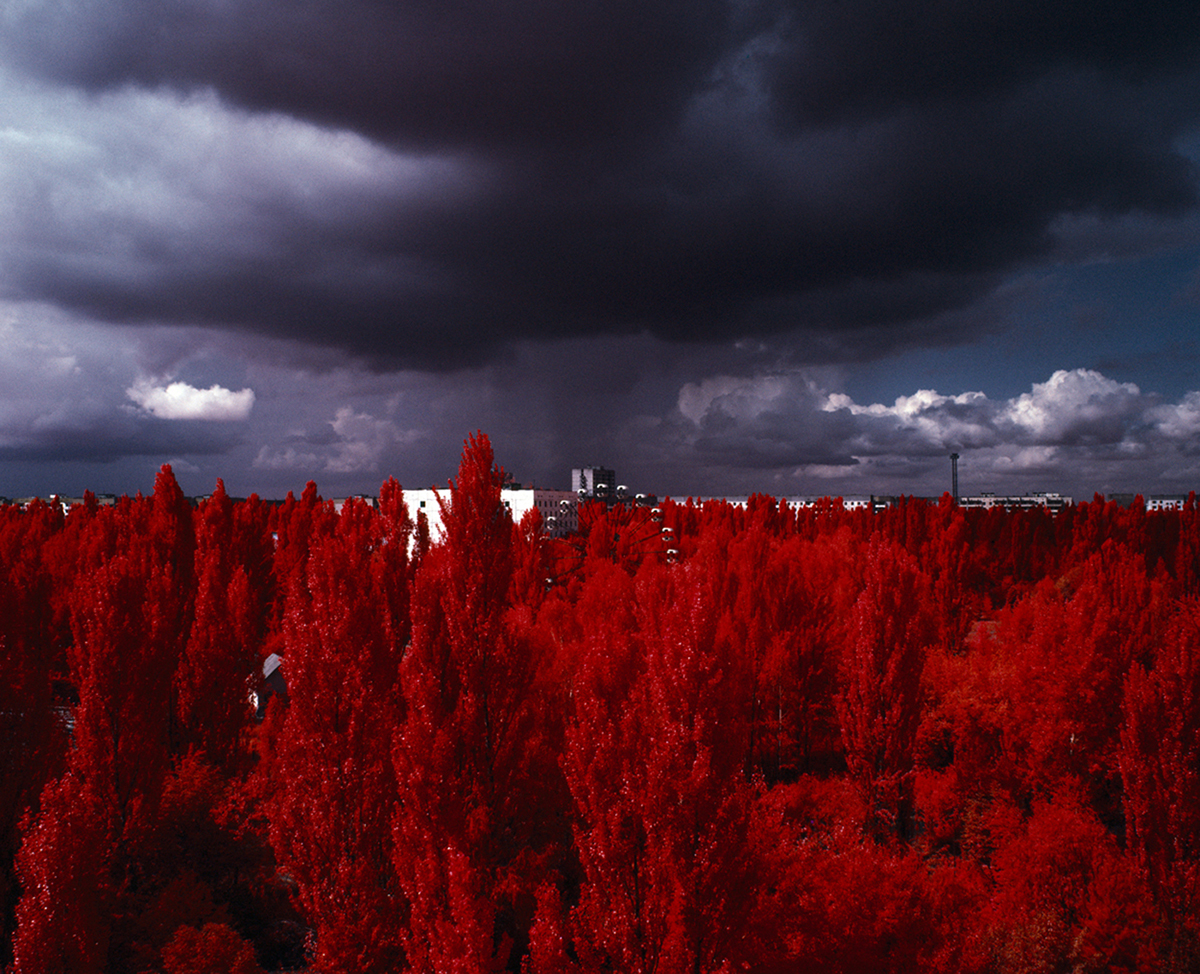Schilt Publishing's new release, The Unseen – An Atlas of Infrared Film is a comprehensive, almost academic, exploration of several uses of infrared film by documentary photographer Edward Thompson. For the better part of the last decade, Thompson has travelled the world – from Ukraine to Northern India – chasing stories and locations to photograph with the last 52 rolls of Kodak Aerochrome Infrared film.
 Studies in Pollution #9. Hyde Park & Buckingham Palace from The City. (2015). England. 120mm CIR Photograph.
Studies in Pollution #9. Hyde Park & Buckingham Palace from The City. (2015). England. 120mm CIR Photograph.  The view from Rose Court from The Villag e. (2010). England. 120mm CIR Photograph.
The view from Rose Court from The Villag e. (2010). England. 120mm CIR Photograph. In his foreword, Thompson recounts a childhood fascination with the spirit world, his membership of a Ghost Club and failed attempts at photographing ghosts using infrared film. This strange obsession with capturing the paranormal in photographs, lead to a personal exploration of what he calls "other more respected fields of science" like medicine, geology, botany and astronomy where infrared film has been historically used towards other ends. For example in forestry, where the infrared colour film can be used to reveal the health of certain species of trees.
 After the Red River Valley. (2012). India. 120mm CIR Photograph; Here infrared film reveals flood damage. All the soil appears white, which indicates that it is devoid of nutrients and life after the flood. Soil with healthy grass and vegetation typically appears bright red on colour infrared film.
After the Red River Valley. (2012). India. 120mm CIR Photograph; Here infrared film reveals flood damage. All the soil appears white, which indicates that it is devoid of nutrients and life after the flood. Soil with healthy grass and vegetation typically appears bright red on colour infrared film. In the book his body of work has been presented in twelve chapters; infrared film is used to a different effect in each. For instance, in a chapter titled The Red Forest he documents the most radioactive forest in the world, where the film itself was affected by radiation, manipulating the appearance of the prints. In another chapter titled The City, stunning aerial shots of London reveals a reddish band of smog and pollutants.
 Hand #6 from The Vein. (2015). 120mm CIR Photograph. In this series Thompson uses historic medical photography techniques, which present a "hyper-real" nudity by making the skin appear thinner and the veins more pronounced.
Hand #6 from The Vein. (2015). 120mm CIR Photograph. In this series Thompson uses historic medical photography techniques, which present a "hyper-real" nudity by making the skin appear thinner and the veins more pronounced. What's perhaps most striking about this photo book is how diverse each chapter and series of photographs is not just in subject matter, but also in aesthetic – it is easy to mistake the book for an anthology featuring the work of several photographers, when it is in fact one artist's triumphant homage to the medium of colour infrared film photography.
 The Northern Lights and a nomaly. (2016). Iceland. 120mm CIR Photograph. Glaciers pictured here appear an intense blue on infrared film.
The Northern Lights and a nomaly. (2016). Iceland. 120mm CIR Photograph. Glaciers pictured here appear an intense blue on infrared film.  Storm approaching Pripyat from The Red Forest. (2012). Exclusion Zone, Chernobyl. 120mm CIR Photograph.
Storm approaching Pripyat from The Red Forest. (2012). Exclusion Zone, Chernobyl. 120mm CIR Photograph. The Unseen – An Atlas of Infrared Plates is published by Schist Publishing (£30) See schiltpublishing.com; edwardthompson.co.uk
Lead image: Studies in Pollution #7. The River Thames from The City. (2014). England. 120mm CIR Photograph.
 The Unseen – An Atlas of Infrared Plates by Edward Thompson, published by Schilt Publishing. Design: Heijdens Karwei, Amsterdam
The Unseen – An Atlas of Infrared Plates by Edward Thompson, published by Schilt Publishing. Design: Heijdens Karwei, Amsterdam Source: The Unseen: infrared photographs of the invisible
No comments:
Post a Comment